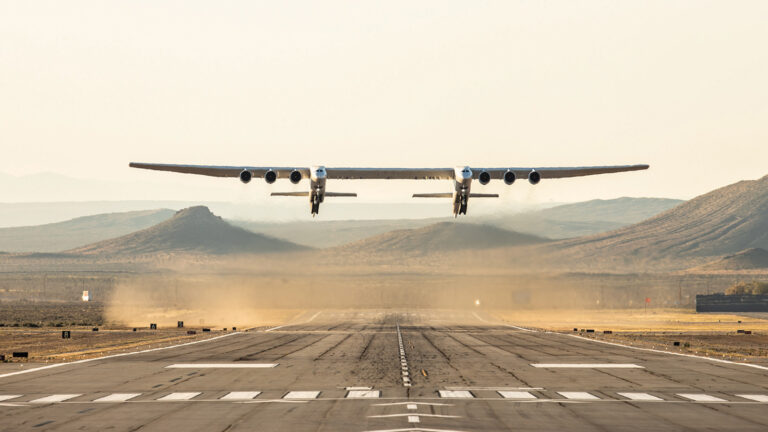Stay Up to Date
Submit your email address to receive the latest industry and Aerospace America news.
The Aircraft Design Technical Committee promotes optimization of aircraft systems, including analysis of their future potential.
Developer Franky Zapata flew a jet-powered hoverboard across the English Channel in August, crossing roughly where Louis Bleirot made the first flight across the channel 110 years previously. In April, pilots evaluated Stratolaunch, a twin-fuselage, six-engine, satellite launcher with a 117-meter wingspan, during a nearly 2½-hour flight from Mojave, California, the aircraft’s first.
This year also saw steady development of major commercial and military programs and intense activity around electric (or hybrid electric) propulsion, autonomous and electric vertical takeoff and landing, or eVTOL, aircraft (many of which are aimed at the urban air mobility market).
Governments continued to nurture potential new aircraft technologies. In July, the European Aviation Safety Agency released its final Special Condition for VTOL aircraft. The rules apply guidance for distributed propulsion vehicles with lift/thrust powerplants, applicable to vehicles with up to nine passengers and a 7,000-pound (3,100 kilograms) gross weight. NASA awarded funds for subsonic-transport electric propulsion studies for potential electrified aircraft propulsion, hoping to lay the groundwork for a future flight demonstrator. Its electric-powered X-57 Maxwell began ground runs of its Mod II in June, testing the electric motors and propellers in an initial spin test. In August, the United Kingdom’s prime minister announced the Future Flight Challenge, funding development of technologies for electric-powered passenger aircraft, cargo drones and urban air taxis.
There were also a few notable first flights among electric and small autonomy vehicles. In January, Boeing’s Aurora Flight Sciences subsidiary completed first flight of its autonomous passenger air vehicle, an eVTOL configuration, at its Virginia facility. Germany-based Lilium Jet’s five-seat prototype, with tilting ducted fans, flew in May. H55’s battery-powered Bristell Energic, a more conventional configuration manufactured by BRM Aero in the Czech Republic, made its first flight in June from Sion, Switzerland. The aircraft has an endurance of 1.5 hours, targeting roughly an hour of pilot training flight time. Also in June, a modified Cessna 337, the Ampaire 337, first flew — its rear engine replaced with an electric motor, powered by lithium-ion batteries. The objective is a configuration with a piston engine optimized for cruise, using the electric motor to supplement for takeoff and climb. The California-based startup Elroy Air flew its Chaparral, an autonomous cargo VTOL drone, in August.
In commercial transport aviation, Airbus launched its A321XLR, the longest-range variant of its A321neo family, targeting to achieve ranges up to 4,700 nautical miles. In April, Embraer obtained regulatory approval from Brazilian, European and U.S. regulatory agencies for its E-195-E2. The latest variant of the E195 demonstrated over 25% lower fuel burn than its predecessor. Also in April, the Polish-built Flaris LAR 1, a single-
engine personal jet, made its first flight. Mitsubishi announced launch of its U.S. scope clause compatible SpaceJet M100 in June. The 76-passenger aircraft will be tailored to work within the operational capacity and weight limitations of many U.S. operators. Two new business jets were certified during the year. Gulfstream achieved FAA Type Certification in June for its G600. In September, Cessna announced its FAA Type Certification of the Cessna Longitude.
On the military side, new developments included flight of the Kratos XQ-58A Valkyrie, an unmanned combat aerial vehicle, in March. The demonstrator was developed under the U.S. Air Force Research Laboratory’s Low-Cost Attritable Aircraft Technology initiative. In March, the Sikorsky-Boeing SB-1 Defiant first flew. The compound helicopter, with rigid coaxial rotors, is targeting the U.S. Army’s Future Vertical Lift program objective of vertical lift with substantially higher cruise speed and ranges than conventional helicopters. Shortly after the Defiant’s first flight, in April, the An-24 replacement Ilyushin Il-112V light military transport made its first flight. In September, Boeing’s MQ-25, an autonomous aerial refueler for the U.S. Navy, flew for the first time.
Related Posts
Stay Up to Date
Submit your email address to receive the latest industry and Aerospace America news.




